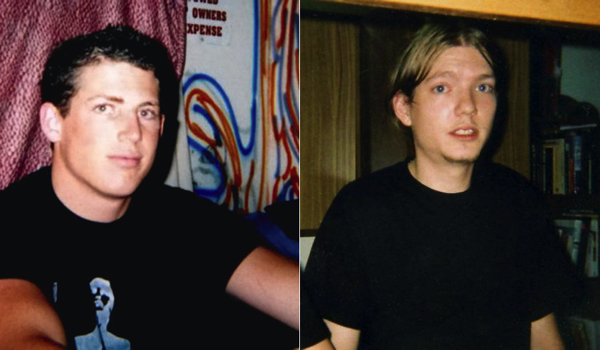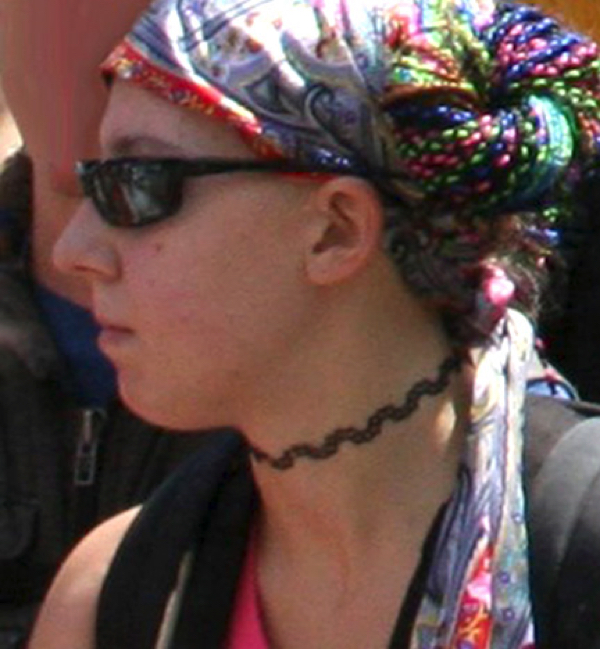Texas 2: David McKay and Bradley Crowder
____________________________________________________
The overarching story here is the blatant size of the federal
government’s strategic operational use of informants and
undercover agents against American citizens protesting eight
years of Republican misrule in the streets of St. Paul.
____________________________________________________
By James Retherford
Originally published in The Rag Blog, Austin, TX, May 26, 2009
The steel door of the United States federal criminal justice system has slammed shut on the cases of the so-called Texas 2. Amidst courtroom drama replete with extraordinary plot twists, the linked stories of Austin activist pals Bradley Neal Crowder and David Guy McKay interweave tumultuous boy-to-manhood coming-of-age themes with the bitter taste of betrayal. Far more disquieting, looming above the northland Minnesota stage, larger, darker questions emerge concerning the role of informers and agents provocateur within activist movements.
On Thursday, May 21, David McKay, a 22-year-old Austin resident accused of making and
possessing Molotov cocktails at last year’s Republican National Convention in St. Paul, MN, was sentenced to four years in federal prison. One week earlier his friend and co-defendant, Brad Crowder, 23 and also from Austin, was sentenced to 24 months on firebomb possession charges.
Crowder and McKay were charged Sept. 3, 2008, after federal authorities, acting on information provided by Brandon Darby, a paid informer who had been highly visible in Austin progressive circles for several years, found eight Molotov cocktails hidden in the basement of a St. Paul apartment building where the two were staying during the convention.
From the outset, the cases against Crowder and McKay were clouded by Darby’s brazen revelation that he was on the FBI payroll. Given his history of bizarre and provocative behavior in Austin and New Orleans, many local activists immediately suspected Darby of manipulating the younger men into a criminal adventure and then busting them.
Indeed, when McKay’s case went to trial in late January, his attorney, Jeff DeGree, staged an aggressive defense around the entrapment argument. Darby’s past statements, such as his stated advocacy of using firebombs to “fight against gentrification,” provided DeGree with a provocateur “quote fest,” and as many as six jurors found Darby’s actions to be over the line. The trial ended in a hung jury.
McKay’s courtroom success was to be short-lived. From the outset, the McKay and Crowder defense teams had no unity of purpose and common courtroom strategy. The government exploited the disunity between the two friends and fellow defendants with great success.
While McKay’s lawyer was planning an aggressive case to put Darby and his FBI handlers on trial, Crowder’s attorney, federal public defender Andrew Mohring — with what appears to be considerable support from Crowder’s family — persuaded the young Austinite to accept a plea bargain on a single charge of possession.
Crowder’s deal was signed in early January, several weeks before McKay was scheduled to go on trial. The government, however, delayed Crowder’s sentencing until after the McKay case was resolved. Though prosecutors did not call Crowder to testify in the McKay trial, they still held his admission of guilt as a trump card that ultimately would become the key factor in McKay’s eventual decision to change his plea to guilty.
Earlier this month, as McKay’s second trial date approached, federal prosecutors announced that this time they would put Crowder on the stand to testify against his friend. They also told Crowder that if he did not co-operate, they would tack two years onto his sentence.
Crowder’s public defender argued that because Crowder had not yet been sentenced, he could not be compelled to give self-incriminating testimony. The government countered by filing a request to grant Crowder immunity, thus compelling his testimony.
In his plea bargain, Crowder had stipulated that, though Darby had become “very influential” in his life and that he looked up to him, the FBI informant had not participated in the firebomb plan “in a direct way.” On the other hand, McKay’s defense had claimed that Darby’s prints were all over the alleged plot. “Brandon Darby created the idea that we, as an affinity group, create multiple Molotov cocktails,” McKay stated on the witness stand in his own defense.
The contradiction between the two defendants’ statements would continue to be a factor as McKay attempted to negotiate a plea bargain earlier this month. District Judge Michael Davis, the same judge who presided over the Crowder case and would pass sentence on both defendants, at first refused to accept McKay’s guilty plea because McKay, in his statement to the judge, did not withdraw his entrapment allegations by repudiating his earlier insistence that Darby unduly influenced his decision to make bombs. With a panel of prospective jurors waiting outside the courtroom, Judge Davis told McKay to think about it and come back the next day.
Among the things McKay and his attorney had to think about was the problem of withdrawing the entrapment argument without exposing McKay to new charges — perjury — for his court testimony.
McKay returned to court the next day and told Judge Davis that he may have misremembered who first brought up the idea of making and using Molotov cocktails. Satisfied that the entrapment defense had been taken off the table voluntarily by McKay, the judge accepted the guilty plea.
____________________________________________________
Why did federal prosecutors push so hard to get guilty pleas from both defendants and to avoid a second trial for McKay? The simple answer: Brandon Darby. He had proved to be a liability in the first trial, and the defense had put together a long list of witnesses prepared to attest to his violent and provocateur-like behavior.
____________________________________________________
Why did federal prosecutors push so hard to get guilty pleas from both defendants and to avoid a second trial for McKay? The simple answer: Brandon Darby. He had proved to be a liability in the first trial, and the defense had put together a long list of witnesses prepared to attest to his violent and provocateur-like behavior.
But there is a far-more-important backstory at play, and that is the question of the scope and credibility of the government’s massive infiltration of peace and environmental activist groups and the incredibility of the Justice Department’s use of post-9/11 anti-terrorism laws against American political dissidents.
The government likes its moles to burrow in deep and avoid the light. Darby turned out to be more moth than mole — he has a penchant for gravitating toward the spotlight. Another key RNC informant, Andrew (Panda) Darst, also wandered too close to the flame.
In a case unrelated to the Texas 2, 23-year-old Matthew Bradley DePalma of Flint, MI, in early March quietly pleaded guilty and was sentenced to 42 months in prison on the charge of possessing Molotov cocktails. The case against DePalma began at a CrimeThinc Convergence in Wisconsin in July 2008 when an FBI informant first met DePalma and reported that DePalma had talked about traveling to the RNC to “make some bombs” and “blow shit up.”
The informant met up with DePalma in Minneapolis in mid-August and helped him procure bomb-making materials and how-to manuals, let him use his residence to manufacture as many as five firebombs, and even drove DePalma to a remote location to test the devices. That FBI informant was Andy Panda Darst.
In addition, Darst is a key government witness in the high-profile case of the RNC 8, Minneapolis area members of the RNC Welcoming Committee who in early September 2008 were indicted on four felony conspiracy and terrorism charges under the Minnesota PATRIOT Act.
Just two weeks before the McKay trial, Darst seriously damaged his value as a creditable witness when he broke down a door and assaulted several people in a house where his wife had sought refuge after a domestic dispute. He was arrested and charged with burglary and assault. Later he was found guilty of felony burglary and assault and on May 18 was sentenced to 180 days in the workhouse with 160 days set aside.
Panda was on the government’s witness list for the McKay trial, but the prosecution did not put him on the stand. The damage to Darst’s credibility as a witness is also believed to have influenced county prosecutor (and Minnesota Democrat gubernatorial candidate) Susan Gaertner’s decision to drop the two terrorism charges against the eight Minneapolis activists — conspiracy to commit riot in furtherance of terrorism and conspiracy to commit criminal damage to property in furtherance of terrorism. All eight still face felony charges of conspiracy to commit riot and conspiracy to commit criminal damage to property.
“Anna” — aka: Anna Davies, Anna Davidson, and Grai Damiani
The plot thickened in 2007 when the FBI persuaded a 17-year-old Florida college student identified as “Anna” in court documents (also known in activist circles as Anna Davies, Anna Davidson, and Grai Damiani) to spend four years undercover — apparently often literally so — building a case against Earth Liberation Front member Eric McDavid on charges of conspiring to damage and destroy property, including government facilities, by means of fire and explosives.
The subsequent trial produced a sordid tale of sexual manipulation and obsession as “Anna” provided McDavid and the two other members of the group with money to buy materials, transportation, and a remote cabin — fully equipped with audio and video surveillance equipment — in which to work. According to McDavid’s attorney, Mark Reichel, Anna was always pushing McDavid and the two other members of the group to do something criminal, taught them how to make the bombs, supervised their activities, and repeatedly threatened to leave them if they didn’t start doing “something.” Friends of the ELF activist say that “Anna” used the promise of sex to manipulate and eventually snare McDavid into a bomb plot concocted and financed by her handlers at the Department of Justice.
After the two co-defendants were pressured into testifying against McDavid, he was found guilty and sentenced to almost 20 years in prison.
In the past few days news channels have been abuzz with the story of the Bronx terrorist bomb plot, four dead-enders with histories of drug addiction, mental illness, and a petty crime (such as purse-snatching) as well as big plans to blow up a New York City synagogue and shoot down military aircraft with Stinger missiles.
Noted the Los Angeles Times: “Prosecutors called it the latest in a string of homegrown terrorism plots hatched after Sept. 11. ‘It’s hard to envision a more chilling plot,’ Assistant U.S. Attorney Eric Snyder said in court Thursday. He described all four suspects as ‘eager to bring death to Jews.’”
To which Robert Dreyfuss, writing in The Nation on May 23, retorts:
“Actually, it’s hard to imagine a stupider, less competent, and less important plot. The four
losers were ensnared by a creepy FBI agent who hung around the mosque in upstate New
York until he found what he was looking for.”
Lurking in the shadows of this sensationalized story is another FBI confidential informant, a man arrested for identity theft in 2002 and given five years probation on the condition that he become an FBI informer.
According to Michael Wilson’s May 21 report in the New York Times, the mole began to show up at a mosque in Newburgh, NY, in 2007, telling prospective targets that he was a recruiter for Jaish-e-Mohammed (the Army of Mohammed), an Islamic mujahadeen organization based in Pakistan. The iman of the Newburgh mosque said that one of his congregants was offered a substantial amount of money to join the informant’s terrorist “team.”
As Dreyfuss emphatically notes:
So a creepy thug buttonholes people at a mosque, foaming at the mouth about violence and
jihad? This is law enforcement? Preying on these losers, the “confidential informant”
orchestrated the acquisition of a disabled Stinger missile to shoot down military planes and
cooked up a wild scheme about attacking a Jewish center in the Bronx.
The informant whipped up their violent tendencies and their hatred of Jews, cooked up the
plot, incited them, arranged their purchase of weapons, and then had them busted. To ensure
that it made headlines, the creepy informant claimed to be representing a Pakistani extremist
group, Jaish-e Muhammad, a bona fide terrorist organization. He wasn’t, of course. …
The headlines reinforce the very fear that Dick Cheney is trying to stir up. The story
strengthens the narrative that the “homeland” is under attack. It’s not.
Is the Bill of Rights under attack? It would seem so in Minnesota where 34 RNC protest cases have come to trial with one conviction.
Correction: zero convictions.
On May 19 a street medic was convicted of public assembly without a permit, but the trial judge himself, in an extraordinary move, overturned the verdict, and the prosecutor has declined to retry the case.
Therefore the murky firebomb conspiracy pleas of DePalma, Crowder, and McKay are the only prosecutorial “successes” to date. Indeed, after the McKay sentence was handed down, the feds must have heaved a collective sigh of relief. Their improperly supervised, out-of-control informants provided just enough to intimidate three young men, two of whom were represented by public defenders, into copping pleas and saving the Justice Department from the sorry spectacle of more public trials — and more revelations about how FBI snitches play fast and loose with the rule of law.



